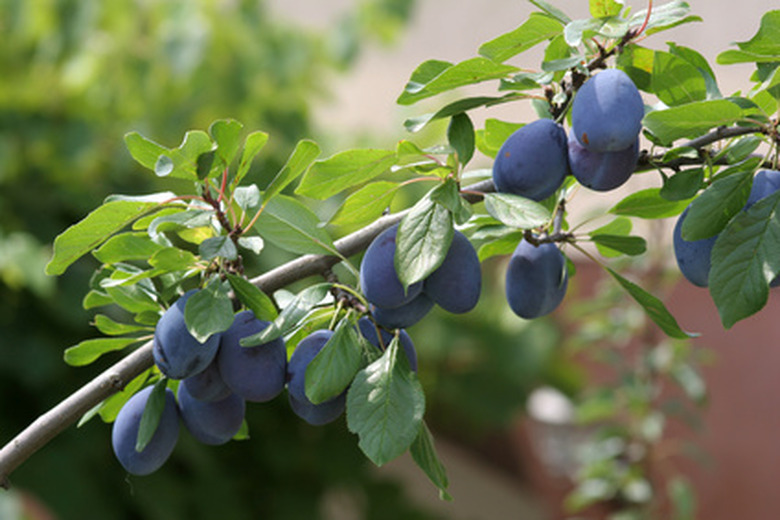How To Prune An Old Plum Tree
Things Needed
- Bleach
- Bucket
- Anvil pruners
- Lopping shears
- Hand saw
While older plum trees bear fruit, the fruit lacks the quality and sweetness of well cared for plum trees. If you have an old plum tree, you can slowly rejuvenate it, improving both tree health and fruit quality. Pruning the plum tree takes a few growing seasons. Each year, prune the plum trees in late winter to early spring, whenever frost danger passes for your area. The University of California notes that a rejuvenation pruning for your plum tree will take three years.
Step 1
Identify any dead, diseased and damaged wood from your old plum tree. Removing this wood keeps the tree healthy. Dead wood won't move in the wind. Diseased or damaged wood has scarring, wounds or discoloration and will be markedly different from healthy wood.
- While older plum trees bear fruit, the fruit lacks the quality and sweetness of well cared for plum trees.
- Pruning the plum tree takes a few growing seasons.
Step 2
Prepare a sanitizing solution by mixing a 1:10 ratio of bleach to water in a bucket. Place your pruning tools in this bucket. Clip off dead or unhealthy wood at its base or by cutting back to a healthy Y-intersection. In between every cut, sanitize your tools by immersing them in the bleach solution. This prevents disease spreading to healthy parts of the tree.
Step 3
Thin out branches that crowd the canopy to improve light and air circulation. Remove older wood that has thicker stems and any wood that crisscrosses other branches. Cut off up to one-third of the wood, then leave the branches alone.
- Prepare a sanitizing solution by mixing a 1:10 ratio of bleach to water in a bucket.
- Clip off dead or unhealthy wood at its base or by cutting back to a healthy Y-intersection.
Step 4
Clip back long branches using lopping shears. Cut them back by one-third of what you wish the final height to be. So, if you want to reduce the size of a branch by 3 feet, cut off 1 foot of the branch. Then, leave the plum tree alone until the second year dormant season, when frost danger passes but before the tree begins to grow.
Step 5
Remove any dead or unhealthy wood the second year in the same manner as you did the first.
Step 6
Trim back long branches by one-third again, in the second year. Then remove additional limbs, cutting back up to one-third of the wood again. By this point, your overgrown plum tree should be cut back drastically. It will produce lots of vigorous shoots. Leave your plum tree alone until mid to late summer.
- Clip back long branches using lopping shears.
- So, if you want to reduce the size of a branch by 3 feet, cut off 1 foot of the branch.
Step 7
Remove fast-growing shoots that emerge from the cuts you made in early spring. Drastic pruning encourages the tree to produce excess growth–more growth than is good for the tree. Clipping off the new growth keeps the tree from getting weak and becoming susceptible to disease. Then leave the tree alone until the following year.
Step 8
Cut off dead or unhealthy wood again, in the third year. Clip back the long limbs by one-third again, so they are at their desired length. Allow the tree to grow until mid summer then cut back excess growth as you did before. Then, allow the tree to grow until the fourth year.
- Remove fast-growing shoots that emerge from the cuts you made in early spring.
- Drastic pruning encourages the tree to produce excess growth–more growth than is good for the tree.
Step 9
Remove dead and unhealthy wood again. Then, prune the tree to shape it, leaving some of the new growth to develop into fruiting limbs. Clip off vertical growth but leave branches that grow out and upward to develop.
Tip
Use lopping shears for growth thicker than 3/4-inch and anvil pruners for thinner growth. Use a hand saw for large limbs you can't cut with lopping shears.
